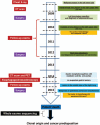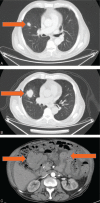Whole exome sequencing of independent lung adenocarcinoma, lung squamous cell carcinoma, and malignant peritoneal mesothelioma: A case report
- PMID: 27902597
- PMCID: PMC5134773
- DOI: 10.1097/MD.0000000000005447
Whole exome sequencing of independent lung adenocarcinoma, lung squamous cell carcinoma, and malignant peritoneal mesothelioma: A case report
Abstract
The presence of multiple primary tumors (MPT) in a single patient has been identified with an increasing frequency. A critical issue is to establish if the second tumor represents an independent primary cancer or a metastasis. Therefore, the assessment of MPT clonal origin might help understand the disease behavior and improve the management/prognosis of the patient.Herein, we report a 73-year-old male smoker who developed 2 primary lung cancers (adenocarcinoma and squamous cell carcinoma) and a malignant peritoneal mesothelioma (PM).Whole exome sequencing (WES) of the 3 tumors and of germline DNA was performed to determine the clonal origin and identify genetic cancer susceptibility.Both lung cancers were characterized by a high mutational rate with distinct mutational profiles and activation of tumor-specific pathways. Conversely, the PM harbored a relative low number of genetic variants and a novel mutation in the WT1 gene that might be involved in the carcinogenesis of nonasbestos-related mesothelioma. Finally, WES of the germinal DNA displayed several single nucleotide polymorphisms in DNA repair genes likely conferring higher cancer susceptibility.Overall, WES did not disclose any somatic genetic variant shared across the 3 tumors, suggesting their clonal independency; however, the carcinogenic effect of smoke combined with a deficiency in DNA repair genes and the patient advanced age might have been responsible for the MPT development. This case highlights the WES importance to define the clonal origin of MPT and susceptibility to cancer.
Conflict of interest statement
The authors have no conflicts of interests to disclose.
Figures




Similar articles
-
Comparative genetic analysis of a rare synchronous collision tumor composed of malignant pleural mesothelioma and primary pulmonary adenocarcinoma.Diagn Pathol. 2016 Apr 18;11:38. doi: 10.1186/s13000-016-0488-0. Diagn Pathol. 2016. PMID: 27091358 Free PMC article.
-
BAP1 mutation is a frequent somatic event in peritoneal malignant mesothelioma.J Transl Med. 2015 Apr 16;13:122. doi: 10.1186/s12967-015-0485-1. J Transl Med. 2015. PMID: 25889843 Free PMC article.
-
Driver Gene and Novel Mutations in Asbestos-Exposed Lung Adenocarcinoma and Malignant Mesothelioma Detected by Exome Sequencing.Lung. 2016 Feb;194(1):125-35. doi: 10.1007/s00408-015-9814-7. Lung. 2016. PMID: 26463840
-
New pathogenic germline variants identified in mesothelioma.Lung Cancer. 2023 May;179:107172. doi: 10.1016/j.lungcan.2023.03.008. Epub 2023 Mar 15. Lung Cancer. 2023. PMID: 36944283 Review.
-
Concurrent mesothelioma and adenocarcinoma of the lung in a patient with asbestosis.Mod Pathol. 1993 Jul;6(4):438-41. Mod Pathol. 1993. PMID: 8415588 Review.
Cited by
-
Whole exome sequencing of lung adenocarcinoma and lung squamous cell carcinoma in one individual: A case report.Thorac Cancer. 2020 Aug;11(8):2361-2364. doi: 10.1111/1759-7714.13540. Epub 2020 Jun 23. Thorac Cancer. 2020. PMID: 32578383 Free PMC article.
-
Integrated Somatic and Germline Whole-Exome Sequencing Analysis in Women with Lung Cancer after a Previous Breast Cancer.Cancers (Basel). 2019 Mar 28;11(4):441. doi: 10.3390/cancers11040441. Cancers (Basel). 2019. PMID: 30925779 Free PMC article.
-
Next generation sequencing driven successful combined treatment with laparoscopic surgery and immunotherapy for relapsed stage IVB cervical and synchronous stage IV lung cancer.Oncotarget. 2019 Mar 12;10(21):2012-2021. doi: 10.18632/oncotarget.26769. eCollection 2019 Mar 12. Oncotarget. 2019. PMID: 31007844 Free PMC article.
-
Second Primary Cancers in a Population-Based Mesothelioma Registry.Cancers (Basel). 2023 Mar 13;15(6):1746. doi: 10.3390/cancers15061746. Cancers (Basel). 2023. PMID: 36980631 Free PMC article.
-
Omic Approach in Non-smoker Female with Lung Squamous Cell Carcinoma Pinpoints to Germline Susceptibility and Personalized Medicine.Cancer Res Treat. 2018 Apr;50(2):356-365. doi: 10.4143/crt.2017.125. Epub 2017 May 26. Cancer Res Treat. 2018. PMID: 28546520 Free PMC article.
References
-
- Xue X, Liu Y, Pan L, et al. Diagnosis of multiple primary lung cancer: a systematic review. J Int Med Res 2013;41:1779–87. - PubMed
-
- Martini N, Melamed MR. Multiple primary lung cancers. J Thorac Cardiovasc Surg 1975;70:606–12. - PubMed
-
- Antakli T, Schaefer RF, Rutherford JE, et al. Second primary lung cancer. Ann Thorac Surg 1995;59:863–6. - PubMed
Publication types
MeSH terms
LinkOut - more resources
Full Text Sources
Other Literature Sources
Medical

